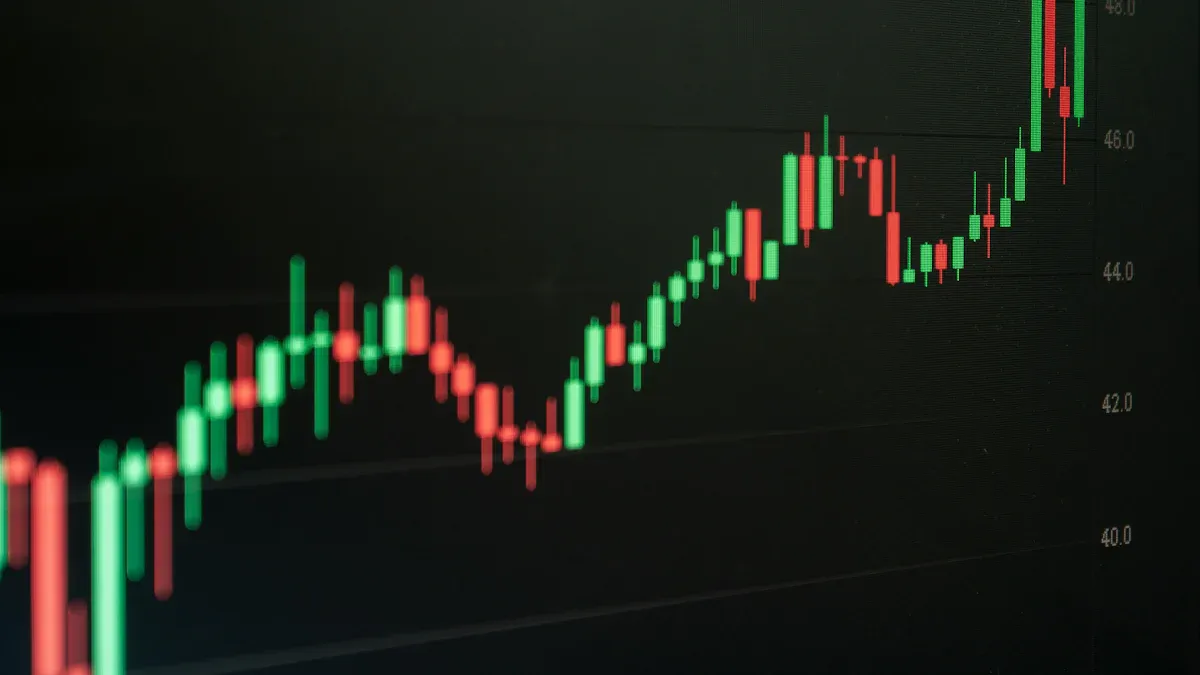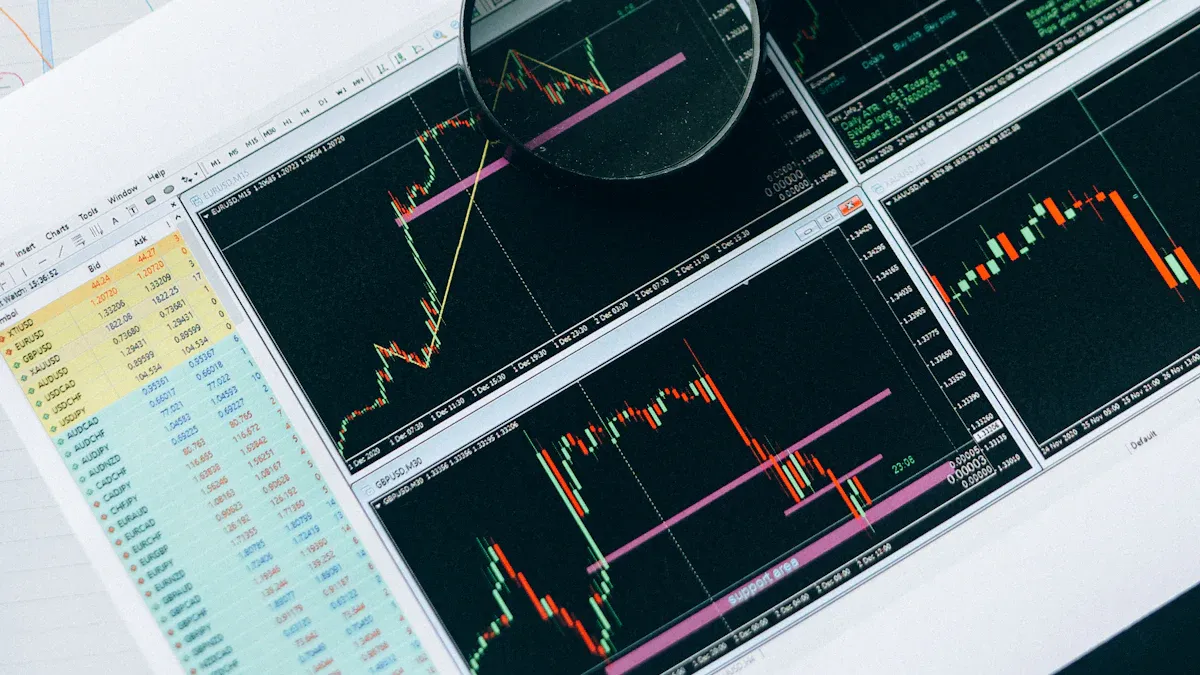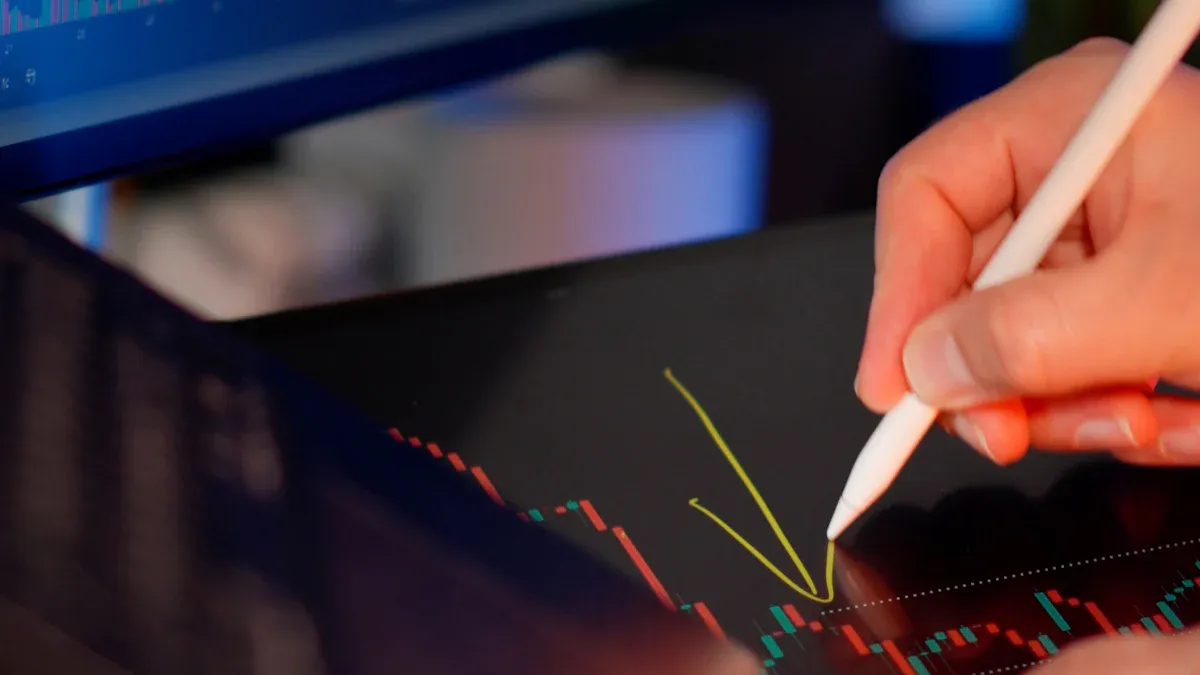- EasyCard
- Trade
- Help
- Announcement
- Academy
- SWIFT Code
- Iban Number
- Referral
- Customer Service
- Blog
- Creator
Golden Cross: Interpreting Bullish Signals and Comprehensive Trading Strategies

Image Source: unsplash
You will find that the golden cross is often regarded as a bullish signal. Taking the S&P 500 as an example, after the last 20 golden crosses, the market had an 85% probability of rising, with an average return exceeding 13%. One year later, the success rate reached 71%. Although historical data supports this view, you need to focus on practical applications and understand the market logic behind the signal to better optimize your trading decisions.
| Time Period | Success Rate | Average Return |
|---|---|---|
| One Year Later | 71% | Over 10% |
| Last 20 Golden Crosses | 85% | Over 13% |
| Since 1928 | N/A | Approximately 8% |
Key Takeaways
- The golden cross is a signal where a short-term moving average breaks above a long-term moving average, typically indicating the onset of a bull market.
- Historical data shows that the market has an 85% probability of rising after a golden cross, with an average return exceeding 13%.
- Combining other technical indicators (such as RSI and MACD) can enhance the accuracy of the golden cross signal and reduce the risk of false signals.
- Setting reasonable stop-loss and take-profit points to align risk management with investment goals can effectively control losses.
- When using the golden cross strategy, periodically evaluate your portfolio and optimize capital allocation based on market conditions to enhance overall investment stability.
Golden Cross Signal

Image Source: pexels
Definition and Principle
When learning technical analysis, you will often encounter the term golden cross. It refers to the phenomenon where a short-term moving average (e.g., 50-day moving average) crosses above a long-term moving average (e.g., 200-day moving average). Many traders believe this signal indicates that the market may be entering a bullish phase. You can refer to the table below to understand the definitions of the golden cross from various authoritative sources:
| Source | Definition |
|---|---|
| Corporate Finance Institute | The golden cross is a fundamental technical indicator that occurs when an asset’s short-term moving average (50-day) rises above its long-term moving average (200-day). Traders view this chart pattern as an indication of a strong bull market. |
| TRADEPRO Academy | The golden cross occurs when a short-term moving average surpasses a long-term moving average, signaling the establishment of bullish momentum and the potential onset of a bull market. |
| TIO Markets | The golden cross is a technical chart pattern that signals a potential bull market when a short-term moving average crosses above a long-term moving average. |
You can see that the core of the golden cross lies in the intersection of the short-term and long-term moving averages. This signal often appears at critical moments when market trends change.
Technical analysts believe that the golden cross is not just a chart phenomenon but also a reflection of market sentiment and capital flow.
Common Parameters
In practice, you will often use different moving average parameters. The most common combination is the 50-day and 200-day moving averages. You can use the following list to quickly understand common settings:
- The 50-day moving average and 200-day moving average are the most commonly used parameters for identifying a golden cross.
- The golden cross typically refers to the 50-day moving average crossing above the 200-day moving average, considered a significant bullish signal.
- Many traders prefer using the 50-day exponential moving average (EMA) and 200-day EMA to increase responsiveness to price changes.
Different moving average periods affect the reliability of the signal. You can refer to the table below to understand the advantages and disadvantages of different periods:
| Moving Average Period | Impact | Description |
|---|---|---|
| Longer Periods | Enhances Predictive Power | Filters out daily fluctuations, providing a clearer safety trajectory |
| 50-day and 200-day | Common Combination | Balances responsiveness and reliability |
| Shorter Periods | May Generate More False Signals | Sensitive to market fluctuations, suitable for day traders |
When choosing parameters, you need to adjust them based on your trading cycle and risk tolerance.
Theoretical Foundation
The theoretical foundation of the golden cross primarily stems from the mathematical principles of moving averages and historical market performance. You can understand its core logic through the following points:
- The golden cross is defined as a short-term moving average (e.g., 50-day) crossing above a long-term moving average (e.g., 200-day).
- Moving average calculations are based on the closing prices of an asset over a specific period.
Historically, the golden cross has appeared at significant market turning points. For example, in May 2020, the S&P 500 index exhibited a golden cross after the COVID-19 market crash, with the 50-day moving average crossing above the 200-day moving average, followed by a significant market rebound. You can observe that in multiple historical instances, bull markets following a golden cross often showed sustained upward trends, enhancing its reliability as a bullish signal.
Academic research has also evaluated the predictive power of the golden cross:
- Souza et al. found that enhanced moving average strategies outperformed the average in BRICS markets.
- Neely et al. demonstrated the feasibility of technical analysis methods in forex markets.
- Dawson and Steeley showed that the predictive power of chart patterns varies by market conditions.
- Shi and Zhao modeled the golden cross using deep neural networks, achieving higher accuracy in 10-year simulations.
- Yoo et al. suggested that combining event-driven variables and machine learning techniques can enhance technical analysis outcomes.
- Abraham et al. proposed that genetic algorithms and random forests have varying efficiencies under different market conditions.
- Kabbani and Usta emphasized that combining news sentiment analysis with technical indicators improves predictive capabilities.
When applying the golden cross, you should combine it with market conditions and other auxiliary tools to enhance the signal’s effectiveness.
Market Significance
Market Phases
When analyzing the market, you often pay attention to the phase in which the golden cross appears. Historical data shows that this signal is most reliable during bull markets and economic expansions. You can refer to the table below to understand the relationship between the golden cross and market phases:
| Source | Evidence |
|---|---|
| The Golden Cross Pattern: Your Guide to Long-Term Bull Market Profits | This pattern produces the best results during bull markets and economic expansions, indicating that the golden cross is more reliable in these market phases. |
| Understanding Golden and Death Crosses: Insights into Historical Performance | The golden cross is typically seen as a precursor to a bullish trend, indicating that the market is moving upward. |
| Golden Cross vs Death Cross (Strategies & Chart Examples) | The golden cross pattern is typically associated with bullish trends, and many traders view it as a reliable signal for entering long positions. |
You will find that the golden cross often appears when the market is just entering an upward cycle. Different asset classes react differently to this signal. For example, the golden cross and death cross in the information technology sector show significant performance differences, while the energy sector focuses more on industry indicators like oil prices. In practice, you need to consider industry characteristics to assess the signal’s effectiveness.
- The golden cross is considered a strong bullish signal, typically appearing at the start of a bull market.
- Different asset classes react differently to the golden cross, with some industries showing weaker responses to these signals.
- The information technology sector shows significant differences in the performance of golden and death crosses, with the death cross potentially indicating buying opportunities in the current bull market.
- The energy sector shows little correlation between golden and death crosses and price performance, with investors focusing more on industry indicators like oil prices.
Sentiment and Trading Volume
When observing market sentiment, you will notice that investors generally become optimistic when a golden cross appears. The short-term moving average crossing above the long-term moving average indicates that upward momentum may persist. Market sentiment typically undergoes a noticeable shift, with increased investor confidence and stronger buying pressure.
- The golden cross typically indicates a shift in market sentiment, suggesting a potential bullish trend.
- The short-term moving average breaking above the long-term moving average indicates that the current upward momentum may continue.
- This is a lagging indicator, typically appearing after significant market movements.
You can also confirm the signal’s validity through changes in trading volume. When a golden cross occurs, trading volume often increases significantly. Higher trading volume indicates stronger market momentum and can help you determine the signal’s reliability.
- The appearance of a golden cross is typically accompanied by an increase in trading volume.
- Higher trading volume can confirm the validity of the golden cross.
- Increased trading volume indicates stronger market momentum.
In actual trading, you can combine market phases, industry characteristics, sentiment changes, and trading volume to comprehensively assess the reliability and limitations of the golden cross signal.
Golden Cross Trading Strategies

Image Source: unsplash
Buying and Holding
In practice, you can use the golden cross signal as a basis for long-term investment entry. The golden cross typically refers to the 50-day simple moving average (SMA) crossing above the 200-day SMA, and this signal has shown stable performance in backtests in the U.S. stock market. You can refer to the table below to understand the core characteristics of buying and holding strategies based on the golden cross:
| Feature | Result |
|---|---|
| Signal Definition | The short-term moving average surpasses the long-term moving average, typically the 50-day SMA exceeding the 200-day SMA. |
| Trading Frequency | Only 33 signals in 66 years, with an average trade duration of approximately 350 days. |
| Risk-Adjusted Returns | The annualized compound growth rate is slightly lower than traditional buy-and-hold strategies, but risk-adjusted returns are higher. |
| Maximum Drawdown | Maximum drawdown is reduced by about half, which is the main attraction of this strategy. |
| Example of Actual Capital Growth | Starting with $100,000 in 1960, the investment would grow to $7.2 million today. |
| Practical Advice | The golden cross is a defensive trend-following filter for long-term stock investments, significantly reducing drawdowns and volatility. |
You can see that after the golden cross signal appears, the holding period is relatively long, averaging nearly a year. Although the annualized compound growth rate is slightly lower than traditional buy-and-hold, the maximum drawdown is significantly reduced, resulting in better risk-adjusted returns. When adopting this strategy in the U.S. stock market, you can effectively filter out market noise and reduce losses from extreme volatility.
Many investors prefer combining other technical indicators to optimize entry timing. For example, when a golden cross appears, you can observe whether the Relative Strength Index (RSI) is in a reasonable range or confirm the trend with changes in trading volume. This can improve the signal’s accuracy and reduce the risk of false breakouts.
- The golden cross and death cross are relatively simple technical tools, especially effective when using long-term moving averages on higher time frames.
- Using the golden cross signal in combination with other technical tools (such as RSI and MACD) can improve profitability.
- You can enter positions gradually after the signal appears to reduce the risk of entering all at once.
Stop-Loss and Take-Profit
When formulating a trading plan, you must set reasonable stop-loss and take-profit points. The golden cross is a trend-following strategy, making stop-loss settings particularly important. You can refer to the following suggestions:
- Before placing orders, determine the risk-reward ratio. A common ratio is 1:2, meaning you are willing to risk $1 for a potential $2 gain.
- Stop-loss orders can be set below the long-term moving average (e.g., 200-day SMA), automatically exiting if the price falls below this line.
- Take-profit orders close positions automatically when a specified profit level is reached. You can determine profit targets based on historical price behavior, support and resistance levels, or a fixed risk-reward ratio (e.g., 2:1).
Tip: You can combine historical highs and key support levels to set take-profit points to avoid exiting prematurely due to market fluctuations.
In practice, you should periodically review stop-loss and take-profit settings to ensure they align with market trends and your personal risk tolerance. This can effectively control losses and lock in profits.
Capital Management
When using the golden cross strategy, capital management is equally important. Proper capital allocation can help you handle market fluctuations and enhance the stability of your overall portfolio. You can refer to the table below to understand common risk management methods:
| Risk Management Strategy | Description |
|---|---|
| Portfolio Diversification | Spread investments across different asset classes to reduce the impact of market fluctuations. |
| Hedging Techniques | Use hedging strategies to protect the portfolio from market uncertainties. |
| Stop-Loss Orders | Set stop-loss orders below the long-term moving average to limit potential losses. |
You can diversify risk through portfolio diversification. For example, when a golden cross signal appears, you can appropriately increase the weight of growth-oriented assets while reducing defensive assets. Regularly rebalance your portfolio to ensure your risk tolerance aligns with your investment goals. You can also use hedging techniques, such as options or ETFs, to further mitigate the impact of market uncertainties.
- Market volatility can expose investors to uncertainty, and effective risk management strategies can mitigate the impact of fluctuations on the portfolio.
- The golden cross serves as a risk management tool, signaling a favorable market trend shift to help you seize growth opportunities.
- Regularly evaluate portfolio structure, combining market trends and auxiliary indicators to optimize capital allocation plans.
In practice, you should collaborate with financial professionals to develop a comprehensive risk management plan. This can enhance the success rate of the golden cross strategy and ensure the achievement of investment goals.
Risks and Pitfalls
Signal Lag
When using the golden cross, you must be aware of its lag. This signal reflects past price movements rather than real-time market changes. You often receive the signal after the trend has already formed, which may cause you to miss the optimal entry point.
- In highly volatile markets, moving averages may frequently cross without a clear trend. You will find prices oscillating, with signals appearing repeatedly, which can cause confusion or even losses.
- You need to understand that the golden cross is more suitable for markets with clear trends. If the market is in a consolidation range, the signal’s effectiveness is significantly reduced.
Handling False Signals
In practice, you will often encounter false signals. To reduce misjudgments, you can adopt the following methods:
- Combine other technical indicators, such as Relative Strength Index (RSI) and Moving Average Convergence Divergence (MACD), to confirm trends and filter out market noise.
- Focus on longer time frames, such as weekly or monthly charts, to smooth out short-term fluctuations and obtain clearer signals.
- Use multi-time-frame analysis, first identifying trends on larger time frames and then finding entry and exit points on smaller time frames to reduce the risk of false signals.
Tip: You can wait for price and trading volume to amplify simultaneously after the signal appears before considering entry.
Trading Costs
When formulating a trading strategy, you cannot ignore the impact of trading costs. Every buy and sell incurs fees and slippage, which accumulate with increased trading frequency, directly affecting your actual returns.
- In the U.S. stock or forex markets, holding positions overnight incurs additional fees. For example, in forex trading, the overnight holding cost for EUR/USD is approximately $0.56 per standard lot per day.
- You also need to consider commissions and slippage. Frequent trading causes these costs to accumulate, potentially eroding most of your profits.
- When calculating strategy returns, you should account for all related fees to obtain a true picture of investment performance.
When using the golden cross strategy, you should combine multiple technical indicators, consider market conditions, and reasonably control trading frequency and costs to avoid common pitfalls and improve overall investment efficiency.
You can see that the golden cross has value as a bullish signal but also has clear limitations:
- As a lagging indicator, the golden cross can only issue signals after a trend is confirmed, unable to predict reversals in advance.
- Studies show that the golden cross has a 33% probability of failing to generate returns within six months and is prone to false signals in range-bound markets.
- Many traders combine indicators like RSI, MACD, and trading volume to enhance signal reliability.
- Experts recommend setting reasonable stop-loss and profit targets and diversifying investments to avoid relying on a single strategy.
| Market Environment | Golden Cross Performance | Notes |
|---|---|---|
| Trending Market | Performs Well | Effectively captures trend changes |
| Range-Bound Market | Prone to False Signals | Frequent false signals lead to losses |
When using the golden cross, you should combine multiple technical indicators and market conditions, flexibly adjust strategies, and rationally evaluate signals to optimize trading decisions.
FAQ
Which markets is the golden cross suitable for?
You can use the golden cross in U.S. stocks, forex, and commodity markets. Many traders have validated the signal’s effectiveness in the S&P 500 and major currency pairs.
How often does the golden cross signal appear?
In the U.S. stock market, you typically see a golden cross every two to three years. The specific frequency depends on market volatility and trend changes.
Can the golden cross guarantee profits?
You cannot rely solely on the golden cross to guarantee profits. Market conditions and false signals can affect outcomes. You need to combine other technical indicators and risk management.
Does trading volume always increase when a golden cross appears?
You will find that trading volume typically increases when a golden cross appears, but this is not always the case. You can use changes in trading volume to assist in evaluating signal reliability.
Are the trading costs of the golden cross strategy high?
When using the golden cross strategy in the U.S. market, trading frequency is relatively low, resulting in lower trading costs. You still need to pay attention to fees and slippage and reasonably control costs.
You now have a deep understanding of the Golden Cross bull signal, recognizing that precise entry and strict risk control combined with RSI and MACD are vital for success. When you identify the signal and are ready to execute the trade, the speed of your capital deployment and the cost of the transaction directly determine your potential returns.
Traditional cross-border remittance and trading methods often cause you to miss the optimal Golden Cross entry point due to high fees and delayed transfers. You need a global fund management platform that supports high-efficiency, low-cost US stock trading.
BiyaPay is your high-efficiency trading accelerator. We offer real-time exchange rate inquiry and conversion for fiat currencies, with remittance fees as low as 0.5%, and zero commission for contract limit orders, helping you minimize transaction costs. BiyaPay supports the conversion between various fiat and cryptocurrencies, enabling you to participate in global market trading, including Stocks, all within one platform. There is no need for a complex overseas account, and you can enjoy same-day remittance and arrival. Click the Real-time Exchange Rate Inquiry now, BiyaPay for quick registration, and use peak capital efficiency to turn the Golden Cross signal into real profits!
*This article is provided for general information purposes and does not constitute legal, tax or other professional advice from BiyaPay or its subsidiaries and its affiliates, and it is not intended as a substitute for obtaining advice from a financial advisor or any other professional.
We make no representations, warranties or warranties, express or implied, as to the accuracy, completeness or timeliness of the contents of this publication.




Contact Us
Company and Team
BiyaPay Products
Customer Services
is a broker-dealer registered with the U.S. Securities and Exchange Commission (SEC) (No.: 802-127417), member of the Financial Industry Regulatory Authority (FINRA) (CRD: 325027), member of the Securities Investor Protection Corporation (SIPC), and regulated by FINRA and SEC.
registered with the US Financial Crimes Enforcement Network (FinCEN), as a Money Services Business (MSB), registration number: 31000218637349, and regulated by FinCEN.
registered as Financial Service Provider (FSP number: FSP1007221) in New Zealand, and is a member of the Financial Dispute Resolution Scheme, a New Zealand independent dispute resolution service provider.




















